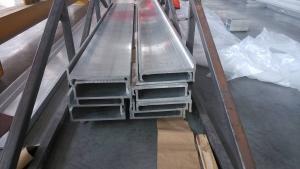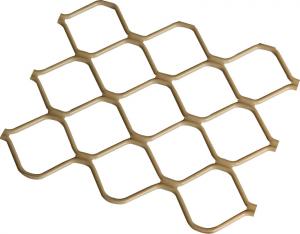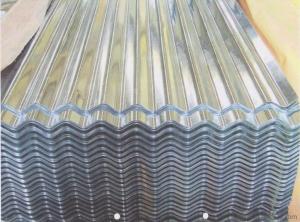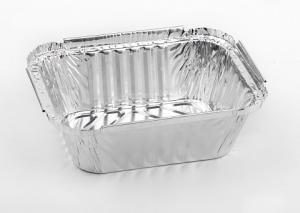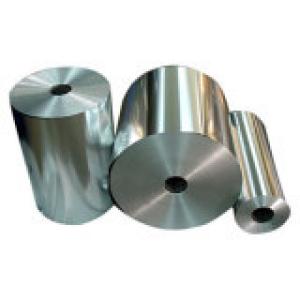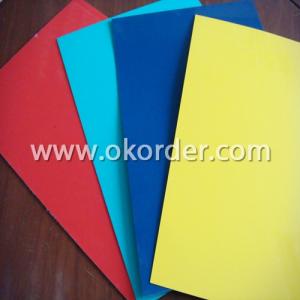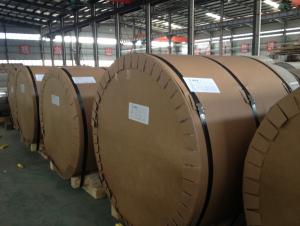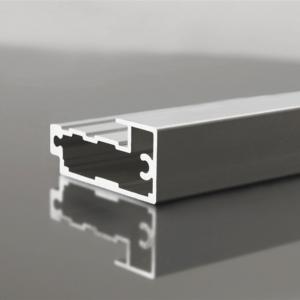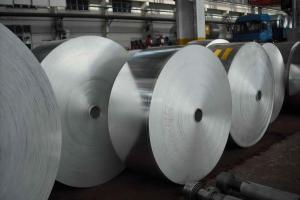Aluminum Container Aluminum Foil
- Loading Port:
- China Main Port
- Payment Terms:
- TT OR LC
- Min Order Qty:
- -
- Supply Capability:
- -
OKorder Service Pledge
OKorder Financial Service
You Might Also Like
Aluminium foil acts as a total barrier to light and oxygen (which cause fats to oxidise or become rancid), odours and flavours, moistness, and germs, it is used broadly in food and pharmaceutical packaging. The purpose of aluminium is to make long-life packs (aseptic processing|aseptic packaging) for drinks and dairy goods, which allows storing without refrigeration. Aluminium foil containers and trays are used to bake pies and to pack takeaway meals, ready snacks and long life pet foods.
Aluminium foil is widely sold into the consumer market, often in rolls of 500 mm (20 in) width and several metres in length.It is used for wrapping food in order to preserve it, for example, when storing leftover food in a refrigerator (where it serves the additional purpose of preventing odour exchange), when taking sandwiches on a journey, or when selling some kinds of take-away or fast food. Tex-Mex restaurants in the United States, for example, typically provide take-away burritos wrapped in aluminium foil.
Aluminium foils thicker than 25 μm (1 mil) are impermeable to oxygen and water. Foils thinner than this become slightly permeable due to minute pinholes caused by the production process.
Aluminium foil has a shiny side and a matte side. The shiny side is produced when the aluminium is rolled during the final pass. It is difficult to produce rollers with a gap fine enough to cope with the foil gauge, therefore, for the final pass, two sheets are rolled at the same time, doubling the thickness of the gauge at entry to the rollers. When the sheets are later separated, the inside surface is dull, and the outside surface is shiny. This difference in the finish has led to the perception that favouring a side has an effect when cooking. While many believe that the different properties keep heat out when wrapped with the shiny finish facing out, and keep heat in with the shiny finish facing inwards, the actual difference is imperceptible without instrumentation.The reflectivity of bright aluminium foil is 88% while dull embossed foil is about 80%.
We provide a full range of precision aluminum strip for almost any application. We produce aluminum strip in a wide variety of alloys, including clad composites. Our aluminum strip can be produced in standard dimensions or custom made to your special requirements. We produce both imperial and metric units. We manufacture in compliance with the main international specifications, and tighter tolerances or custom tempers are available upon request. We offer various surface conditions, custom finishes (painting, anodizing, embossing), special processing, and multiple packaging options to meet our customer's unique requirements. The following is a summary of our capabilities.
Manufactured in compliance with the main international specifications and standards, including: Aluminum Association, ASTM, EN, and DIN.
We can also manufacture in compliance with other international standards including:ASME, SAE, AMS, AWS, FED, MIL, QQ, ISO, BS, AFNOR, JIS and GOST.
Manufactured in compliance with the main international specifications and standards.
Tighter tolerances are available upon request.
Aluminium (or aluminum; see spelling differences) is a chemical element in the boron group with symbol Al and atomic number 13. It is a silvery white, soft, ductile metal. Aluminium is the third most abundant element (after oxygen and silicon), and the most abundant metal in the Earth's crust. It makes up about 8% by weight of the Earth's solid surface. Aluminium metal is so chemically reactive that native specimens are rare and limited to extreme reducing environments. Instead, it is found combined in over 270 different minerals.The chief ore of aluminium is bauxite.
Aluminium is remarkable for the metal's low density and for its ability to resist corrosion due to the phenomenon of passivation. Structural components made from aluminium and its alloys are vital to the aerospace industry and are important in other areas of transportation and structural materials. The most useful compounds of aluminium, at least on a weight basis, are the oxides and sulfates.
Despite its prevalence in the environment, no known form of life uses aluminium salts metabolically. In keeping with its pervasiveness, aluminium is well tolerated by plants and animals. Owing to their prevalence, potential beneficial (or otherwise) biological roles of aluminium compounds are of continuing interest.
The earliest citation given in the Oxford English Dictionary for any word used as a name for this element is alumium, which British chemist and inventor Humphry Davy employed in 1808 for the metal he was trying to isolate electrolytically from the mineral alumina. The citation is from the journal Philosophical Transactions of the Royal Society of London: "Had I been so fortunate as to have obtained more certain evidences on this subject, and to have procured the metallic substances I was in search of, I should have proposed for them the names of silicium, alumium, zirconium, and glucium."
Davy settled on aluminum by the time he published his 1812 book Chemical Philosophy: "This substance appears to contain a peculiar metal, but as yet Aluminum has not been obtained in a perfectly free state, though alloys of it with other metalline substances have been procured sufficiently distinct to indicate the probable nature of alumina."[69] But the same year, an anonymous contributor to the Quarterly Review, a British political-literary journal, in a review of Davy's book, objected to aluminum and proposed the name aluminium, "for so we shall take the liberty of writing the word, in preference to aluminum, which has a less classical sound."
The -ium suffix conformed to the precedent set in other newly discovered elements of the time: potassium, sodium, magnesium, calcium, and strontium (all of which Davy isolated himself). Nevertheless, -um spellings for elements were not unknown at the time, as for example platinum, known to Europeans since the 16th century, molybdenum, discovered in 1778, and tantalum, discovered in 1802. The -um suffix is consistent with the universal spelling alumina for the oxide (as opposed to aluminia), as lanthana is the oxide of lanthanum, and magnesia, ceria, and thoria are the oxides of magnesium, cerium, and thorium respectively.
The aluminum spelling is used in the Webster's Dictionary of 1828. In his advertising handbill for his new electrolytic method of producing the metal in 1892, Charles Martin Hall used the -um spelling, despite his constant use of the -ium spelling in all the patents[58] he filed between 1886 and 1903. It has consequently been suggested[by whom?] that the spelling reflects an easier-to-pronounce word with one fewer syllable, or that the spelling on the flyer was a mistake.[citation needed] Hall's domination of production of the metal ensured that aluminum became the standard English spelling in North America.
- Q: I have a 2000 Jeep Cherokee sport and I have replaced the radiator 3 times (average lifespan 1.5 years)Every time it has failed at the top passenger side corner where the aluminum fins are soldered to the aluminum tubeNOT where aluminum meets the plastic.It was replaced by a professional with an OEM radiatorIs it possible that racking in the frame due to bad sway bar bushings or harsh Michigan roads could cause this problemSame location of the break I am not having over heating issues before radiator breaks.I am using correct coolant mixture.
- Definately leave it in the aluminum tinIf you don't it will be a huge mess.
- Q: styrofoam is kinda weird b/c it seems to allow stuff to get through, it's not liek plastic that is waterproofi worry about the freezer water getting into the food.
- Metamucil fiber pills are what I takeI haven't noticed any irritation of any sortAnd I like the fact that I can simply swallow a pill, as opposed to eating a bowl of cardboard cereallol
- Q: Does aluminum gain or lose electrons? How many electrons are gained or lost?
- Aluminum is a metal, and metals only lose electrons to form ionsBut keep in mind that aluminum ONLY actually loses any electrons when a compound of aluminum dissociates in waterAnd when it does, it usually loses three electrons to form the +3 charge, although the +1 oxidation state is also a possibilityFinally, aluminum actually shares electrons within an compound.
- Q: Can aluminum sheets be used for cladding?
- Yes, aluminum sheets can definitely be used for cladding. Aluminum is a popular choice for cladding due to its many beneficial properties. It is lightweight, durable, corrosion-resistant, and has excellent thermal and acoustic insulation properties. It is also highly malleable, allowing for various design possibilities. Aluminum cladding is commonly used in both residential and commercial buildings to provide protection, enhance aesthetics, and improve energy efficiency.
- Q: That could crawl out by itself?
- If you are interested in High voltage work, you should realise that you don't need them to be solidCopper hemispheres will be fine made of thin sheetIf you go to garden centres or craft shops you may find hollow metal spheres on saleIf you get really stuck - get a solid sphere - or even a doorknob and use adhesive and thin copper foil to cover itThe big boys use copper wire mesh - for BIG things.
- Q: Are aluminum coils resistant to chemical exposure?
- Yes, aluminum coils are generally resistant to chemical exposure. Aluminum is known for its excellent chemical resistance, making it suitable for various industrial applications where it may come into contact with different chemicals. However, the specific level of resistance can vary depending on the type and concentration of the chemical involved.
- Q: I've been thinking about perhaps ombreing my hair but instead of going and buying a hair color kit could I instead just use my 'sun in' hair product to dye the ends for a not too bold look? and if so how should I go about doing that? should I soak it in? I need answers!
- I have ombré hair! I got it done in the hair salon, and she parted my hair into sections, and then literally died half blonde and wrapped aluminum foil where the dye wasIt was so easy.I got mine too bold but it's fineI have medium brown hair and got a really light blondeI would try doing that sun in, but if all fails you can just dye itPart you hair at the crown depending on thickness, then dye half of your hairJust do it in sections and you will be fineJust spray the sun in into a bowl or something and you can even take your fingersGood luck!
- Q: I have a very old round metal tub that my grandmother used to wash clothes in with a washboardI think it is made of a heavy aluminum, but I'm not sureWould this be safe to use for a backyard fire pit? If so, do I need to drill holes in the bottom or put a screen on the top?
- don't cook it at any temp over 350 I do 20 min a lb but i like a nice bloody beef 275 is the lowest id go for heat but it will take longer remember it still is cooking after you pull it out for i guess 15-20 min
- Q: I know it's completely random, but I have a purpose.Say the section is about 5 meters long and the bleachers are titanium.I'll love you if you help me out.
- Since the density of titanium is about 4500 kg/m^3 and the density of aluminum is about 2700 kg/m^3, a set of titanium bleachers will weigh 1.7 times more than a set of aluminum bleachers, given that they have the same geometry If you really want to know, would suggest that you find a style of bleachers that you like, which will probably be made out of aluminum, call the company and get the weight, and then multiply it by 1.7Just don't tell them why you need the weight, because they might laugh at you.
- Q: I have a 1990 Toyota Celica GtIts white and i want to paint it.I am going to have to sand down everything, but dont know what kind of sand paper i should useWhat Types of sand paper will i need to complete this task?
- Low Bicycles? I wonder if they ever considered running that brand name through a focus-group?
Send your message to us
Aluminum Container Aluminum Foil
- Loading Port:
- China Main Port
- Payment Terms:
- TT OR LC
- Min Order Qty:
- -
- Supply Capability:
- -
OKorder Service Pledge
OKorder Financial Service
Similar products
Hot products
Hot Searches
Related keywords











